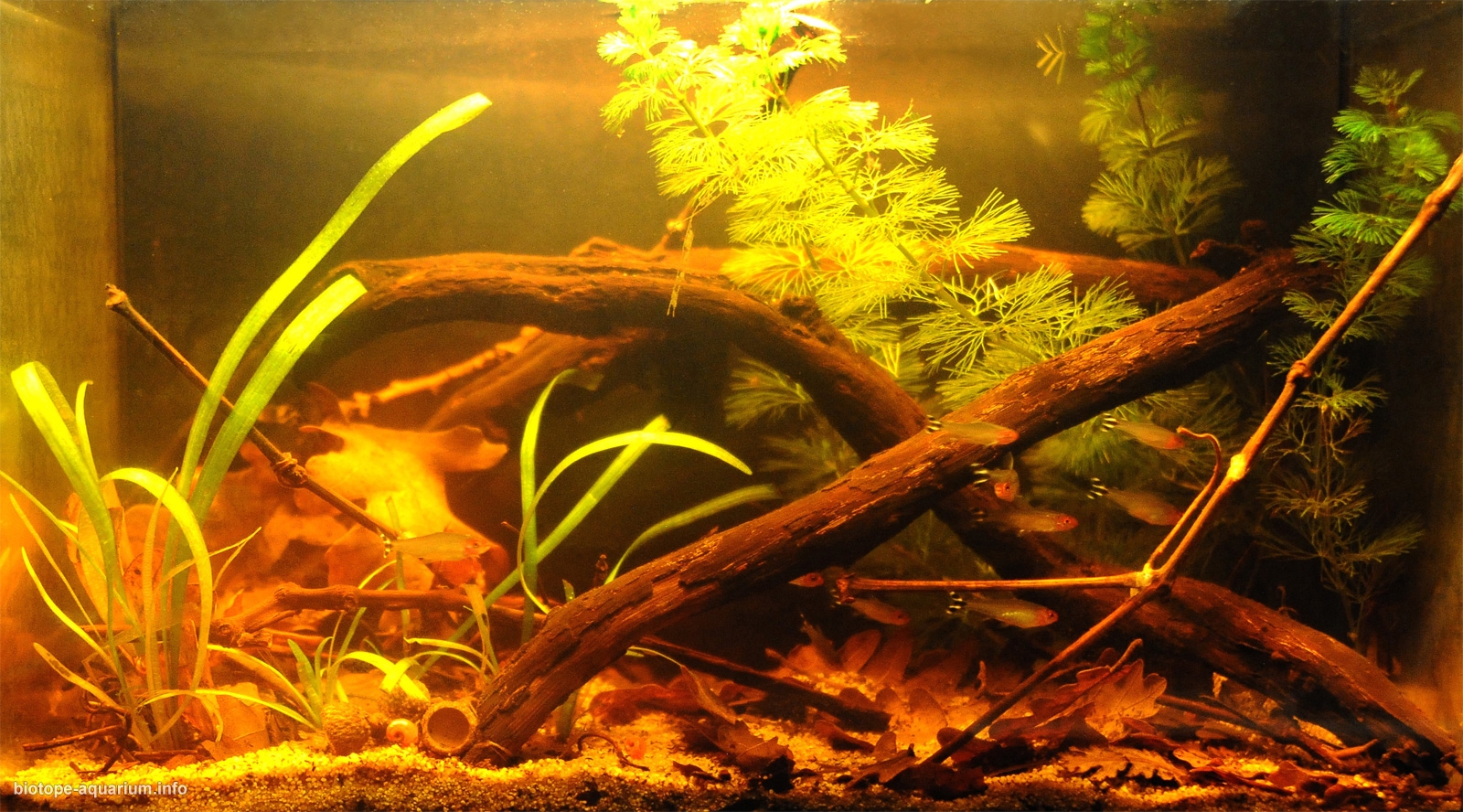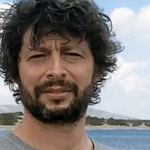Rio Orinoco – Hemigrammus rhodostomus biotope
97th place in Biotope Aquarium Design Contest 2017
![]() Turkey. Görkem Elvir Kartal
Turkey. Görkem Elvir Kartal

Volume: 30 L
Dimensions: 40x25x30 cm
List of fishes: Hemigrammus rhodostomus, Planorbis rubrum
List of plants: Sagittaria subulata, Cabomba caroliniana
Description of decorations: Grape tree, oak leaf, acorn
Description of equipment: Atman aquarium air pump AT-A7500, RS-50W heater, 8 W daylight lamp
Water parameters: Temperature 27°C, pH: 6.1
Description of the area surrounding the biotope: The main river bed of the Orinoco Basin, which includes Colombia, Venezuela and Guyana, is entirely located in Venezuela. Orinoco, 2140 km in length, empties into the Atlantic ocean and forms a large delta of 41,000 km². In fact, Amazon is not a part of the river system. However, it connects via Casquiare to Rio Negro and indirectly joins Amazon. Anacaro, Guanipa, Morichal Grande, San Juan, Uracoa, Manamo, Araguao, Macareo, Marius, Imataca, Ventuari, Atabapo, Suapure, Cuchivero or Caura, Aro, Paragua and Caron are Orinoco’s branches forming the basin. The region has temperature values ranging from 25 to 32°C. In addition, 2700 mm of annual precipitation, which is obtained by proportioning all the basins, is almost evenly divided into every month. This is a demonstration of the slight change in water level in Orinoco and an explanation for its clear waters. It has been observed that the pH level of the river varies between 5.2-6.3. The annual output of the Meta river portion is 5600 cubic meters/hour average, which forms the driest part of the system. On the contrary, the delta part is rather stagnant and swampy. The Orinoco delta plains form one of South America’s largest wetland complexes. This ocean-stream intersection area is a highly efficient feeding and breeding place for a range of freshwater and marine organisms. Due to these positive factors, both aquatic fauna and flora are quite rich. The largest quantity of the species exceeding 900 is in the Characiformes family. It is followed by the Loricariidae and Cichlidae families. Approximately 70 species are mentioned in the literature as endemic for Orinoco. Among these endemic creatures are some pleco species, a few apistogramma species, some tetras and some killifish species. Micropoecilia bifurca is also a species native to Orinoco. Orinoco hosts Geophagus as well. Geophagus grammepareius and G. taeniopareius are the most common species. Corydoras black Venezuela, M. ramirezi, P. natteri, cardinal tetra, sail-finned stingray, Dicrossus filamentosus are the well-known aquarium fish from Orinoco. The underwater view differs to the delta. The organic and mechanical sediments are more abundant as the wear to this region decreases and the accumulation increases. The area is a part of andesite based Guyana Shield. Andesite and derivation stones can be used in Orinoco aquaria. Orinoco is the richest river in species in all of South America. Clear waters and the majority of the basin located in the savannah cause more sun light. This is very important in terms of plant growth. Here you can find Echinodorus species including parvula, subulata, Salvinia, Riccia, N. lotus, water hyacinth, Cabomba, some Alternanthera, Bacopa, Hydrocotyle, Heteranthera and Vallisneria species. An Orinoco biotope should have an absolutely clear water of very slightly yellowish color. Fine beige sand is suitable for aquarium. Larger stream gravel can be used in parts for plant growth. For this region, the branches and roots will be the main hardscape materials. Orinoco covers a vast expanse of land and makes quite a different kind of living. It is very important to pay attention to the hunting relationship. Feeding cardinal tetra with coarse food would be a big mistake. Smaller volumes of 60 liters (such as Rio Xingu and Rio Negro) can be used, and larger volumes are suitable for Orinoco biotopes.
Description of the parameters of the habitat: Temperature is 24-27°C,
pH is 5.5-7.0. Colours of the fish will become faded if kept in alkaline conditions. Hardness is 2-15°dGH.
List of fishes: Aequidens diadema, Aequidens metae, Aequidens tetramerus, Ancistrus sp., Apistogamma iniridae, Apistogamma hoignei, Apistogamma hongsloi, Apistogamma macmasteri, Apistogamma viejita, Astronotus ocellatus, Axelrodia riesei, Biotodoma wavrini, Biotoecus opercularis, Carnegiella marthae, Cichla orinocensis, Cichlasoma bimaculatum, Corydoras Black Venezuela, Corydoras brevirostris, Corydoras concolor, Corydoras delphax, Corydoras habrosus, Dicrossus filamentosus, Farlowella acus, Geophagus dicrozoster, Gymnocorymbus ternetzi, Hemigrammus rhodostomus, Heros severus, Hypancistrus contradens, Megalamphodus sweglesi, Mikrogeophagus ramirezi, Otocinclus affinis, Panaque nigrolineatus, Paracheirodon axelrodi, Paracheirodon simulans, Potamotrygon motoro, Pristella maxillaris, Pterophyllum altum, Pterophyllum scalare, Pterygoplichthys multiradiatus, Uaru fernandezyepezi.
List of plants: Helanthium tenellum, Cabomba piauhyensis, Echinodorus tennellus, Echinodorus cordifolius, Echinodorus sp., Cabomba aqatica, Mayaca fluviatilis, Eleocharis sp., Sagittaria subulata, Hydrocotyle leucocephala, Cabomba caroliniana.
Threats to the ecology: Orinoco River major is a river of South America that flows in a giant arc for some 1,700 miles (2,740 km) from its source in the Guiana Highlands to its mouth on the Atlantic Ocean. Throughout most of its course it flows through Venezuela, except for a section that forms part of the frontier between Venezuela and Colombia. The name Orinoco is derived from Warao (Guarauno) words meaning “a place to paddle” – i.e., a navigable place. The Orinoco and its tributaries constitute the northernmost of South America’s four major river systems. Bordered by the Andes Mountains to the west and the north, the Guiana Highlands to the east, and the Amazon watershed to the south, the river basin covers an area of about 948,000 square km. It encompasses approximately four-fifths of Venezuela and one-fourth of Colombia. For most of its length, the Orinoco flows through impenetrable rain forest or through the vast grassland (savanna) region of the llanos (“plains”), which occupies three-fifths of the Orinoco basin north of the Guaviare River and west of the lower Orinoco River and the Guiana Highlands. The savanna was given its name by the Spaniards in the 16th century and long has been used as a vast cattle range. Since the 1930s this region has been developing into one of the most industrialized areas of South America.
Sources of information: Akvaryum.com; Seriouslyfish.com; Britannica.com.
Comments of the members of the jury of Biotope Aquarium Design Contest 2017

Again, this aquarium is too small for fish, and there are oak leaves and acorns in South American setup. Grape tree is ok to use, because it sometimes can resemble driftwood from tropical areas.

In this entry I did not see the artistic part of the aquarium. In addition, in South America along the rivers there are no oaks (from where are there oak leaves and caps of acorns in the water?)

This aquarium lacks personality. You forget about it as soon as you close its photo. Almost everything and almost everywhere can look like this – including the school biology classroom. I would like to see a little more creativity from the authors.
